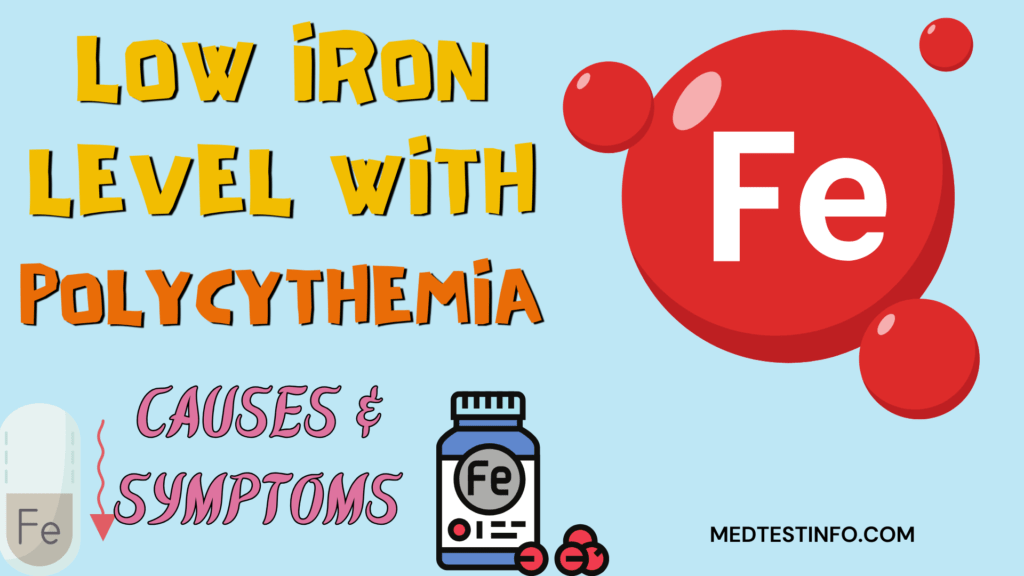
Overview
Polycythemia vera (PV) is a rare blood disorder that causes the body to create excessive red blood cells, resulting in thicker blood, potential problems, and an increased risk of blood clots. Despite the surplus of red blood cells, some people with PV suffer from iron insufficiency, usually accompanied by a lack of red blood cells. This contradiction poses a few questions: Why are iron levels low with polycythemia? Can polycythemia vera and anemia coexist, and how does this affect the body?
In this article, we will examine the reasons for iron shortage in polycythemia vera, review diagnostic markers, and offer advice on balancing iron levels for PV patients. We’ll also discuss dietary changes, common symptoms of polycythemia vera, and treatment alternatives.
Polycythemia Vera: Primary Vs Secondary
Polycythemia vera (PV) is a type of blood condition known as myeloproliferative neoplasms (MPNs), in which the bone marrow generates giant red blood cells. PV is distinguished by the JAK2 gene mutation, which causes bone marrow to produce more red cells than required. Unlike secondary polycythemia, which is caused by extrinsic factors such as low oxygen levels or tumors that release erythropoietin, PV is inherent in the bone marrow’s activity. This distinction is critical in understanding why polycythemia vera and secondary polycythemia require different treatment strategies.
Common Symptoms Of Polycythemia Vera
Fatigue and weakness due to the thicker blood’s effect on oxygen delivery.
Headaches, dizziness, and visual abnormalities result from increased blood volume.
Itching and red skin, particularly after exposure to warm water, are associated with elevated histamine levels in the blood.
Thicker blood puts more strain on the cardiovascular system, causing shortness of breath and chest pain.
PV symptoms may overlap with anemia, particularly when iron shortage is present, causing fatigue and poor energy.
Why Can Iron Deficiency Coexist With Polycythemia?
Iron deficiency and polycythemia appear to be opposites since polycythemia vera boosts the production of red blood cells. This process usually depends on having enough iron in the body. However, some factors, particularly phlebotomy therapy, can lead to iron deficiency in people with polycythemia. Phlebotomy is a standard procedure to help manage excess red blood cells, gradually removing blood and iron from the body. This can lead to a situation where iron levels drop, resulting in iron deficiency even when an excess of red blood cells is produced.
To manage polycythemia effectively, it’s essential to understand how iron deficiency can exist alongside it. Monitoring iron levels and making the right treatment changes can support a healthy balance and enhance the overall well-being of those living with polycythemia vera.
The Function Of Phlebotomy In Iron Depletion
Phlebotomy therapy is essential in controlling PV since it removes blood to reduce red cell count and prevent problems. However, each phlebotomy treatment removes iron alongside red cells, thereby depleting iron stores. Frequent blood draws over time can deplete the body’s iron supply, resulting in iron deficiency anemia despite elevated red blood cell counts.
The Body’s Iron Demand
The body’s iron needs are high with PV because red cells are constantly produced. Patients may develop anemia and polycythemia if the bone marrow does not receive enough iron. This may appear counterintuitive because polycythemia indicates large red blood cell counts, yet without enough iron, these cells may be less efficient at delivering oxygen, adding to weariness and weakness.
Impaired Iron Absorption
In addition to phlebotomy, some PV patients have poor iron absorption, making it difficult to maintain adequate iron levels despite dietary intake. Other variables, such as pharmaceutical interactions or underlying gastrointestinal disorders, may exacerbate this, reducing iron absorption from the digestive tract.
Diagnostic Tests And Lab Values For Polycythemia Vera
Accurate diagnostic tests are essential for patients with polycythemia vera (PV). These tests help confirm the condition, check for iron deficiency, and assess how thick the blood has become. A complete blood count (CBC) is one of the main tests used to help diagnose PV. Everyday observations show higher levels of hematocrit, hemoglobin, and red blood cell counts, suggesting an increased production of red blood cells.
The lab results can reveal some unexpected patterns when polycythemia vera is present alongside notable iron deficiency. In these situations, hemoglobin levels might seem normal or lower than expected, even when red blood cell counts are high. This happens because a lack of iron restricts the body’s capacity to create hemoglobin, even if the production of red blood cells is high.
Regular blood tests, such as checking CBC values and iron levels, are essential in effectively understanding and managing polycythemia vera. When healthcare providers spot these lab abnormalities, they can effectively tailor treatment plans to tackle both blood thickening and iron deficiency.
Key Laboratory Markers For PV
Hemoglobin and hematocrit are frequently elevated in PV, indicating increased red cell mass. Iron deficiency, conversely, can cause hemoglobin to decrease, resulting in anemia known as polycythemia.
Ferritin: A low ferritin level indicates depleted iron stores and is commonly seen in PV patients who undergo regular phlebotomy.
Erythropoietin (EPO): PV is characterized by low EPO levels in the blood, which occur when the body downregulates intrinsic erythropoietin production in response to the JAK2 mutation.
JAK2 Mutation Testing: Most PV cases test positive for this mutation, which is uncommon in secondary polycythemia. This test helps to distinguish PV from other causes of elevated red blood cell counts.
These polycythemia blood test results can help physicians monitor iron levels and adapt treatment to maintain balanced red blood cell production while avoiding iron deficiency.
Dietary And Supplemental Considerations For PV Patients
It might be difficult for people with polycythemia vera (PV) to control their iron levels with diet and supplements. In contrast to standard anemia, where increasing iron in the diet is often recommended, individuals with PV need to be conscious of their iron consumption to prevent stimulating an overproduction of red blood cells.
It might seem surprising, but introducing iron supplements or iron-rich foods too early can worsen PV symptoms by encouraging more red blood cell production. So, when it comes to managing polycythemia vera, dietary approaches aim to keep iron levels steady while avoiding potential issues.
Patients should collaborate with their healthcare providers or dietitians to create a balanced diet that supports their overall well-being. They should also regularly monitor their iron levels to prevent deficiencies and manage the risk of blood thickening.
Dietary Tips For Balancing Iron Levels
Avoid Excessive Vitamin C: High vitamin C intake can improve iron absorption. Thus, PV patients should avoid large dosages, particularly around meals. Certain vitamins and supplements may aggravate PV symptoms. Vitamins to avoid with polycythemia vera include iron supplements (unless prescribed) and excessive doses of vitamin B12, which can enhance red blood cell formation.
Include: Include non-heme iron foods such as spinach, lentils, and beans, which have a milder effect on iron absorption than heme sources (meats).
Limit Heme Iron: Consuming foods heavy in heme iron, such as red meat, in moderation, can help prevent the development of more red blood cells.
Hemochromatosis And Polycythemia
Polycythaemia vera (PV) and hemochromatosis are different blood disorders, yet unusual blood profiles characterize both. Hemochromatosis results in excess iron in the body, leading to a buildup in vital organs such as the liver, heart, and pancreas, which can cause chronic damage over time. On the other hand, people with PV frequently experience low iron levels, particularly when they undergo phlebotomy therapy to help manage their condition.
The goals for treating these conditions vary quite a bit. The main goal of PV is to lower the number of red blood cells to help avoid the thickening of the blood and the complications that can come with it. In managing hemochromatosis, the main goal is to reduce iron levels to prevent any harm to the organs from too much iron accumulation.
This comparison emphasizes the crucial importance of providing personalized care when dealing with conditions like polycythemia vera, hemochromatosis, or secondary polycythemia. Getting the correct diagnosis, customized treatment, and consistent check-ins are crucial for preventing complications and providing adequate care for every condition.
Conclusion
Balancing iron levels in polycythemia vera is critical for symptom management and risk reduction. Treatments such as phlebotomy can cause iron deficiency over time, impairing the body’s ability to supply oxygen properly and resulting in weariness and weakness. Patients can effectively maintain PV and iron levels by eating a well-balanced diet, getting regular blood tests, and working with their doctors.
Understanding the paradox of iron shortage in polycythemia vera allows patients and healthcare providers to make more educated decisions that improve overall quality of life and health outcomes.
Frequently Asked Questions (FAQs)
Anaemia and polycythemia vera (PV) can exist together, especially in individuals with regular phlebotomies. Although PV boosts the production of red blood cells, too much blood removal through phlebotomy can drain iron stores, resulting in iron-deficiency anemia. This may lead to feelings of tiredness and weakness, even if the overall production of red cells is high.
Phlebotomy involves removing red blood cells, which also means removing the iron they hold. With time, frequent blood draws can affect the body’s iron reserves, leading to lower iron levels. To tackle this, individuals might benefit from a well-rounded diet or specific iron supplements, ideally with the support of a healthcare professional.
Nutrition is essential for effectively managing PV. An iron-rich diet can be beneficial for those dealing with anemia. However, patients with PV should be mindful of their iron consumption to prevent an overproduction of red blood cells. Talking to a healthcare provider or dietitian can help create a personalized diet that keeps your iron levels healthy while also considering your PV symptoms.
Polycythaemia vera can affect how energetic you feel. Too many red blood cells can thicken the blood, making it harder for it to flow and deliver oxygen to our tissues. When combined with iron deficiency from phlebotomies, this can often result in feelings of fatigue, weakness, and a decrease in stamina. Caring for red blood cell counts and iron levels boosts energy and enhances overall well-being.


